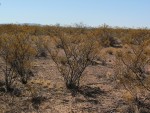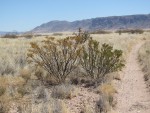Many images come to mind when the one thinks of desert fieldwork in central New Mexico. Low precipitation, large fluctuations in temperature, high solar radiation—the desert is a stressful place. But one stress many people rarely associate with deserts in the southwestern U.S. is extreme cold. Although often overlooked, cold temperatures play an important role in desert ecosystems.
In February 2011, record low temperatures swept through the Southwest. Sites where minimum winter temperatures rarely exceeded -20°C suddenly experienced several days of temperatures reaching -29°C. Low temperatures had visibly negative impacts on plant communities, particularly in the desert shrublands. Creosote (Larrea tridentata), the common Chihuahuan desert shrub that provides the quintessential smell of “desert”, showed the most obvious change. Shrublands dominated by creosote, which typically remain green year round, transformed into a sea of brown. Everywhere you drove around the flats of the Sevilleta National Wildlife Refuge all you saw was brown. The desert has so little green to begin with, especially during winter, and for a botanist in love with green, it was heartbreaking to see everything instantly turn brown. But hidden beneath the canopy death was also an exciting research opportunity.
Creosote is known to respond poorly to cold temperatures. When exposed to cold temperatures water passage through the plant’s transport tissue is disrupted, harming above-ground plant tissues in mature shrubs and killing creosote seedlings. The northern limit of creosote’s range in the Chihuahuan desert is dictated by cold temperature, with a thin slice of the population following the Rio Grande basin into central New Mexico and extending roughly 48 km north of the Sevilleta National Wildlife Refuge. Previous research on the response of creosote to cold temperatures has been limited to the lab, since natural extreme cold events are infrequent and unpredictable. But the cold temperatures of February 2011 set up the perfect experiment, allowing us to examine how creosote responds to natural cold events along its northern range.
Following the freeze, field surveys indicated that freeze-induced canopy death was extensive. All the surveyed shrubs had some degree of canopy death. Indeed, canopy death was not only widespread but intensive at the canopy level, with 97 percent of the shrubs experiencing at least 75 percent canopy death. However, canopy death was variable across the landscape and shrubs in the grassland fared better than those in shrublands. Continued monitoring after the freeze also indicated that shrubs in the ecotone, the transition area between shrubland and grassland, were quicker to resprout than those in the shrubland. As with any unexpected event leading to extensive death, our investigation has led to some interesting questions. Why was individual response to cold temperatures so variable? How long will it take shrubs to replace the biomass lost during the freeze? Were similar response patterns seen in other shrublands in the Southwest?
Focusing in, we will examine anatomical and physiological traits that may explain why individuals at different sites showed different responses to the freeze event. The water conducting tissues in plants – the xylem – vary greatly among plants but also between plants of the same species. We will determine if the variability in the xylem of Sevilleta creosote explains the variation we observe in canopy dieback. Similarly, the capacity for plant cells to withstand cold temperatures is variable within a population. Our investigation will determine whether some creosote shrubs exhibit greater resilience to extreme cold events due to these cellular traits.
Widening our view across the landscape, we will also investigate how this die-back event impacts ecosystem function. The on-going study of ecosystem exchange of carbon dioxide and water at creosote shrub sites directed by Dr. Marcy Litvak (SEV) will be used to determine how these extreme climate events can impact biosphere-atmosphere interactions. Scaling up, we are investigating the detectability of the freeze event from space using remote sensing images – work that will allow us to assess creosote damage throughout the Southwest. We’re also teaming up with investigators Craig Tweedie (University of Texas, El Paso) and Dawn Browning (USDA-ARS) to do cross-site comparisons with the Jornada LTER. Together, we’re investigating the effects of the freeze at a variety of scales, a collaboration that will enhance our understanding of how climate impacts these unique arid ecosystems.
Our research is still in its infancy, as desert perennials can take several years to rebound from disturbance and the freeze occurred eight months ago. It is unclear how long it will take shrubs to return to their pre-freeze dimensions and functions. From this one freeze event we are learning about variation in physiological responses throughout the population, differential community responses between shrublands and ecotones, the influence of extensive canopy death on ecosystem carbon fluxes, and landscape patterns of death and recovery. Keep your eyes open for research opportunities, they might just show up in the most unexpected ways.

 Enlarge this image
Enlarge this image
